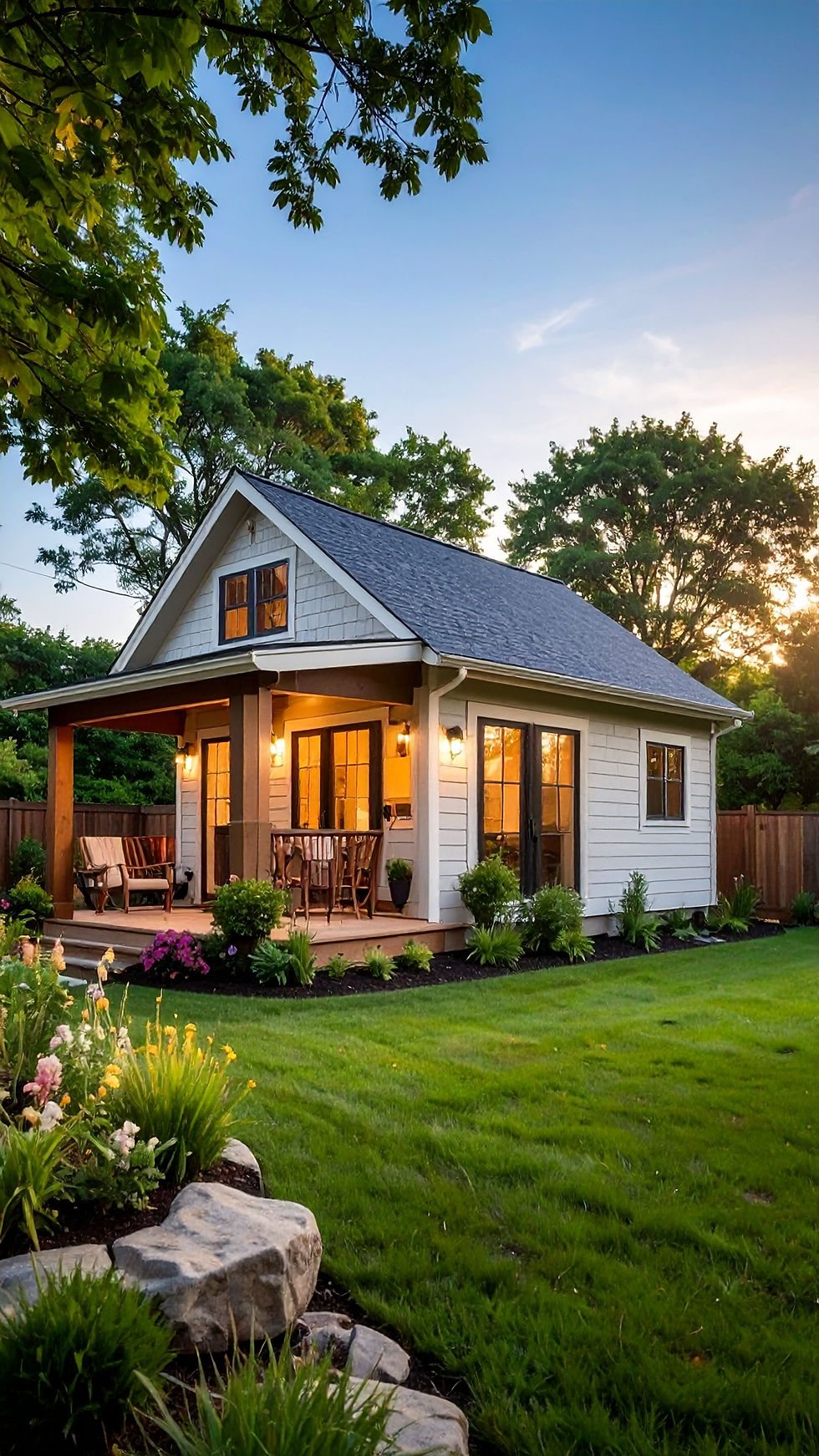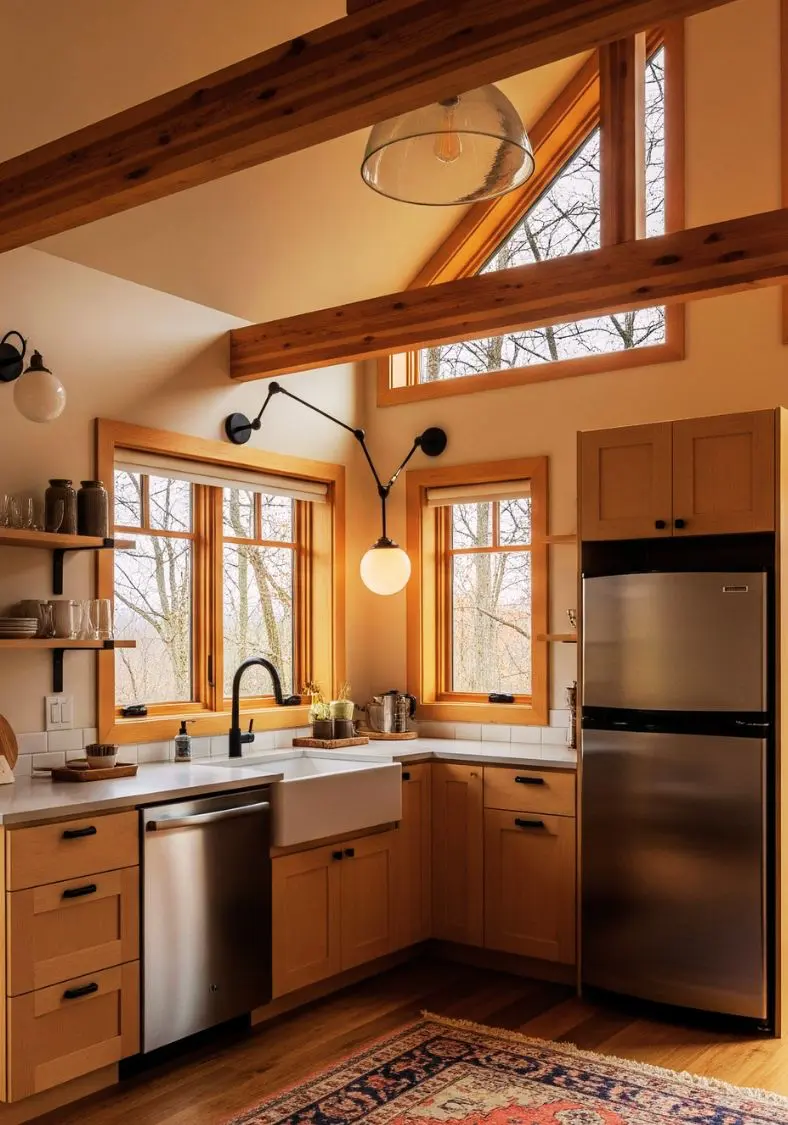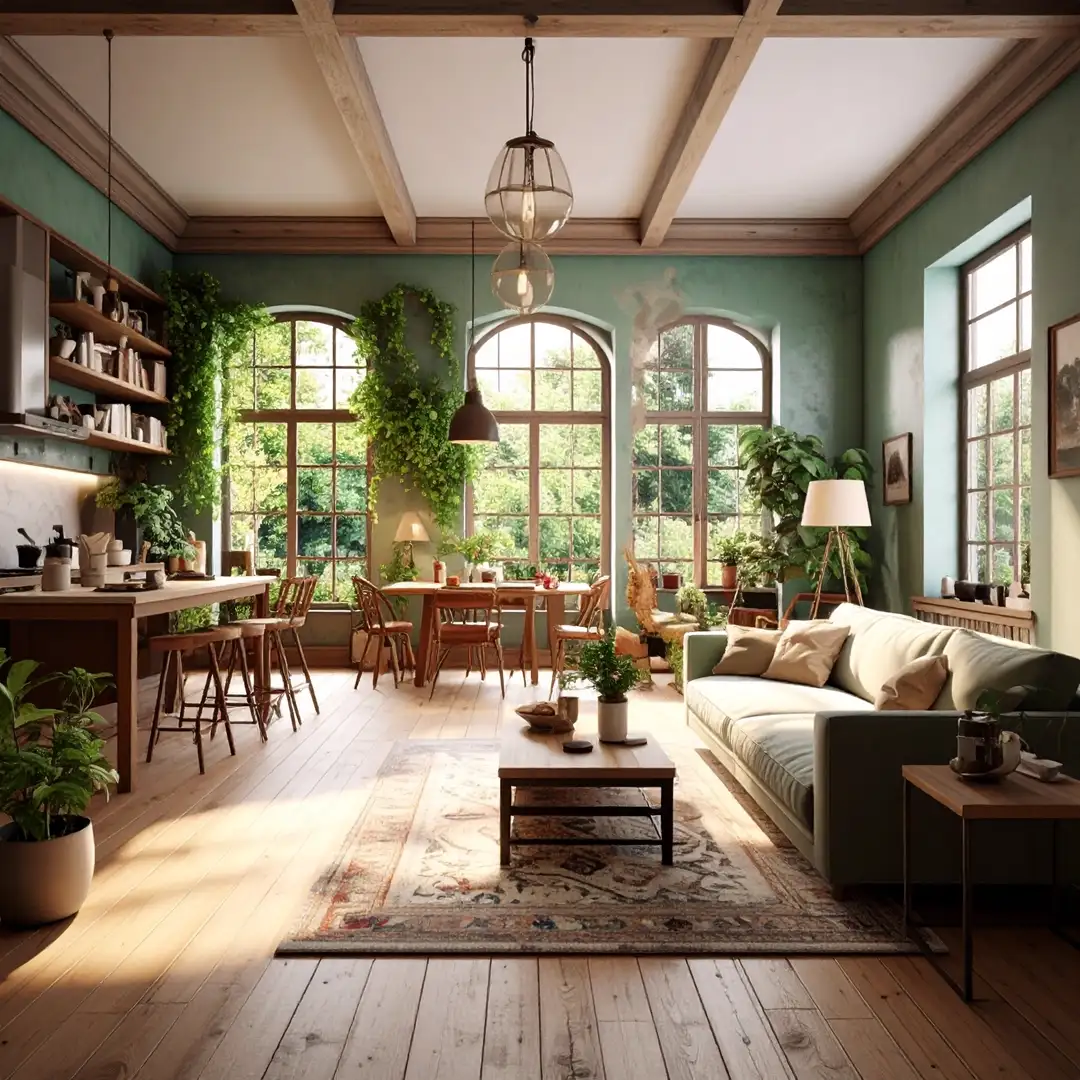Connecticut ADU Design + Build Guide (2025)
- Daniel Peragallo
- Aug 3
- 8 min read

Land, lumber, labor, just about everything that goes into building a house is getting more expensive, here in Connecticut and across the county. It makes sense that a growing number of people are turning to Accessory Dwelling Units.
ADUs work great as in-law suites, guest buildings, and for multi-generational families looking to make aging parents or adult children more comfortable at home. We've also seen them pop up as short term rentals and investment opportunities, and as a quick way to boost your home's appeal before a sale.
Regardless of why you're building an ADU, now's the perfect time: Regulations have changed across the state, and most towns and cities allow ADUs than ever.
Understanding ADUs: What Connecticut Homeowners Need to Know
An Accessory Dwelling Unit, sometimes called an in-law suite, backyard cottage, or guest house, is a self-contained, smaller home built on your property. They’re a flexible approach to adding living space and boosting property values, and with smart design, they can help to elevate the rest of your home as well.
Quick ADU Facts:
Average cost: $150,000–$300,000
Timeline: 7–12 months (planning, permits, construction)
Typical sizes: 400–1,200 sq ft
Budget Concerns?:
Stick to a one-story build.
Keep your footprint simple (less corners.)
Use quality materials for what matters: It's easier to upgrade fixtures and appliances than cheap looking painted drywall or cracked budget tiles.
ADU Designs + Styles (That Actually Work in Connecticut)
Let’s talk through a few design styles that local homeowners are asking for—and why they work so well in Connecticut backyards.

Modern Farmhouse
Still a homeowner favorite in Connecticut's rural-urban blend areas like Woodbridge or Bethany, this style offers comfort with updated charm
Key features: Shiplap walls, pitched metal roofs, apron sinks, neutral palettes (white, beige, gray).
Where it fits: Great for blending with Cape-style or ranch homes.
Pro Tip: Reclaimed barn wood accents add that authentic look, without blowing your budget on antique furniture or fancy trim moulding.

Contemporary
Ideal for homeowners in more modern areas or for detached ADUs behind newer homes, especially in suburban communities.
Key features: Clean lines, flat or shed roofs, large windows, open concepts.
Where it fits: Pairs well with mid-century or modern primary homes.
Pro Tip: Fiber cement siding gives a clean look that's sturdy, reliable, and holds up to our infamous Connecticut winter climate.

Mid-Century Modern
Popular in communities where 1950s and 60s ranch homes are common. Connecticut is home to some of the most distinctive MCM homes, and it’s no surprise this style is widely sought after even today.
Key features: Clerestory windows, flat planes, minimalist interiors.
Where it fits: Well-suited for rectangular lots with open yard space.
Pro Tip: Natural wood, Art Deco furniture, and bright white interiors are a quick route to a classic MCM look.
Other Timeless ADU Styles To Consider Borrowing From:

Scandi-Chic
Minimalist and calming with natural materials
Light wood accents, neutral palettes, uncluttered spaces

Industrial
Rugged yet refined using steel, brick, and glass.
Open spaces, raw finishes, industrial lighting

Coastal/Nautical
Light, breezy, and relaxing—perfect for Connecticut’s shoreline.
Whites, blues, nautical decor and motifs
Choosing the Right ADU Design & Floorplan
Picking the right ADU layout really comes down to how it’s going to be used.
If it’s for guests, short-term renters, or a home office setup, a studio layout makes a lot of sense—less square footage, lower cost, and easier to tuck into tight spaces.
But if you’re housing in-laws, adult kids, or planning for long-term renters, a separate bedroom layout gives you the privacy and livability people actually want.
We’ve built both, and each has its place depending on the goal. Just don’t let Instagram fool you—layout matters more than finishes when it comes to functionality.
Studio Layouts
300–500 sq ft
Great for tight spaces and small budgets.
Ideal for: Singles, home offices, short-term rentals
Budget range: $100,000–$150,000
Separate Bedroom Layouts
500–800 sq ft
Balances privacy with space effeciency.
Ideal for: Couples, aging parents, longer-term renters
Budget range: $150,000–$250,000
What Makes an ADU Look Right in CT
We’ve seen some out-of-place builds—giant glass cubes plopped behind colonials. Don’t be that house (Unless you're dead set, never selling, and know the neighbors won't care.)
ADUs should compliment the primary building in style, size, and placement:
Match rooflines and siding materials to your main home, especially on attached ADUs.
Keep colors matching or using contrast effectively
Balance the build size and your remaining yard size.
If you're dead set on a style that "doesn't match the neighborhood," make sure to take into account any local building regulations on appearance, as well as the potential impact if you want to sell down the road.
Construction Insights: Practical Tips for Connecticut ADUs
What Else Do You Need To Know?
Like any remodeling project, ADUs are complex and involve tons of different systems working in harmony. They're too much to cover on one page, so be sure to check out our other ADU blogs on Permits, Construction Tips, Town Regulations, and the whole ADU process.
Your ADU journey should balance style, functionality, and local compliance. By selecting the right design style and layout, understanding costs and timelines, and leaning on professional guidance, you're set up for success.
At Peragallo Construction, we believe in straight talk and solid craftsmanship. When you're ready to take your Connecticut ADU from vision to reality, we're here to help. No fluff—just the facts and guidance you need to build something you'll be proud of.
Ready To Start? Let Us Build It For You!

I started Peragallo Construction to make a difference for Connecticut's homeowners: I believe in straight talk, helping people out, and bringing back a respect for solid American craftsmanship.
If you're ready to take your ADU from vision to reality, we're nearby, we're here to help.
FAQ: Answers to Common Connecticut ADU Questions
How much does it cost to build an ADU in Connecticut?
Building an ADU in Connecticut typically costs between $160,000 and $350,000, depending on size, location, finishes, and whether it's detached, above a garage, or part of a basement conversion. Costs run higher in towns like Greenwich, Woodbridge or West Hartford where property values and design standards skew upscale.
Site conditions, sewer connection requirements, and custom finishes can all increase the total. You’ll want a builder who gives you a line-item proposal with final costs, not just an estimate.
Is it legal to build an ADU on my property in Connecticut?
Yes, ADUs are legal in Connecticut, but zoning rules vary by town. Since 2021, state law has made it easier for homeowners to build them, but some municipalities like Cheshire or Fairfield have opted out or added their own restrictions. Check with your local zoning office or work with a contractor who actually understands the patchwork of local rules.
How long does it take to build an ADU in Connecticut?
On average, plan for 6 to 9 months from design to final inspection. This includes design, permits, site prep, construction, and inspections. Detached ADUs typically take longer than conversions. Permitting delays or specialty work (like tying into a septic system) can stretch the timeline. A good contractor should help you avoid surprises and keep things moving.
Do ADUs increase property value in Connecticut?
Yes, a well-built ADU can add $100,000 or more to your property value, especially in towns with tight rental markets. Appraisers consider square footage, quality of construction, and rental income potential. If your ADU is beautifully finished and meets local code, it’s a strong investment—whether you're renting it out or using it as in-law space.
What’s the difference between an ADU and a guest house?
An ADU is a self-contained living unit with its own kitchen, bathroom, and separate entrance. A guest house may not have a kitchen or be designed for long-term occupancy. Connecticut law only recognizes structures as ADUs if they meet specific criteria, including zoning, size limits, and sometimes occupancy rules. Don't let a builder sell you a "guest house" that doesn’t pass zoning.
Can I rent out my ADU in Connecticut?
In most towns, yes. ADUs can legally be rented long-term (typically 30 days or more). Short-term rentals like Airbnb are another story—rules vary widely by town. Some require owner-occupancy or ban short-term rentals outright. Always check your local ordinances before counting on rental income.
Do I need a permit to build an ADU in Connecticut?
Building an ADU in Connecticut absolutely requires permits. You'll need building permits, zoning approval, and inspections—even for garage or basement conversions. Skipping permits might save time upfront, but it can tank your appraisal, resale value, or insurance. Work with a licensed contractor who handles permitting and talks straight about what’s allowed.
How big can an ADU be in Connecticut?
Most towns cap ADUs at 1,000 to 1,200 square feet or 30% of the main home’s square footage—whichever is smaller. Detached units often face stricter setbacks and lot coverage rules. Every town has its own version of what’s allowed, so design flexibility depends heavily on your location and lot size.
Can I convert my basement or garage into an ADU in CT?
Yes, converting a basement or garage into an ADU is allowed in Connecticut. but they must meet code: ceiling heights, egress windows, separate entrances, and full kitchens and bathrooms. Basements are often easier to legalize than detached units, but waterproofing, insulation, and HVAC upgrades may be required. Garage ADUs can be a great option if the structure is sound.
What’s the ROI on an ADU rental in Connecticut?
A well-designed ADU can bring in $1,200–$2,200/month in long-term rental income, depending on your town. In places like New Haven, Hamden, or West Hartford, there's strong demand for one-bedroom rentals. ADUs typically see higher ROI when kept simple and efficient—fewer custom finishes, more functionality.
What should I avoid when planning an ADU?
When planning an ADU build, avoid designing before you’ve checked zoning, underestimating utility connection costs, and hiring contractors who’ve never built an ADU in Connecticut. It’s not just a mini-house. It’s subject to its own building code section, zoning overlays, and local politics. And make sure you’re thinking about long-term maintenance and resale, not just the look.
Can an ADU be attached to the main house?
Yes, in Connecticut, ADUs can be attached or detached. Many homeowners opt for additions or bump-outs to keep everything under one roof and simplify utility connections. Attached ADUs may be easier to permit and cheaper to build—but they may also impact your privacy more.
Do I need separate utilities for an ADU?
Not all ADUs need separate utilities, but it depends on your local municipalities restrictions. You can usually share water, sewer, and electric with the main house, especially for in-law or family use. If you're renting it out, metering separately is a good idea. Detached units may require trenching new lines or adding subpanels. Always check with your building department or a licensed plumber/electrician.
Will building an ADU raise my property taxes?
Yes, but not dramatically. The added living space increases your assessed value, which can raise your annual tax bill by a few hundred to a few thousand dollars, depending on town and ADU size. But if you’re renting the unit, the income often offsets the tax bump.
Can I use an ADU for short-term rentals like Airbnb?
Some Connecticut towns allow it, many restrict it. Towns like New Haven or Hartford have fewer restrictions, while others ban short-term rentals entirely or limit them to owner-occupied properties. Don’t assume Airbnb is allowed just because someone down the road is doing it. Check your zoning regulations before building.













Comments